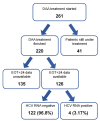Hepatitis C Screening and Treatment Program in Hungarian Prisons in the Era of Direct Acting Antiviral Agents
- PMID: 35215901
- PMCID: PMC8876701
- DOI: 10.3390/v14020308
Hepatitis C Screening and Treatment Program in Hungarian Prisons in the Era of Direct Acting Antiviral Agents
Abstract
A hepatitis C virus (HCV) screening and treatment program was conducted in Hungarian prisons on a voluntary basis. After HCV-RNA testing and genotyping for anti-HCV positives, treatments with direct-acting antiviral agents were commenced by hepatologists who visited the institutions monthly. Patients were supervised by the prisons' medical staff. Data were retrospectively collected from the Hungarian Hepatitis Treatment Registry, from the Health Registry of Prisons, and from participating hepatologists. Eighty-four percent of Hungarian prisons participated, meaning a total of 5779 individuals (28% of the inmate population) underwent screening. HCV-RNA positivity was confirmed in 317/5779 cases (5.49%); 261/317 (82.3%) started treatment. Ninety-nine percent of them admitted previous intravenous drug use. So far, 220 patients received full treatment and 41 patients are still on treatment. Based on the available end of treatment (EOT) + 24 weeks timepoint data, per protocol sustained virologic response rate was 96.8%. In conclusion, the Hungarian prison screening and treatment program, with the active participation of hepatologists and the prisons' medical staff, is a well-functioning model. Through the Hungarian experience, we emphasize that the "test-and-treat" principle is feasible and effective at micro-eliminating HCV in prisons, where infection rate, as well as history of intravenous drug usage, are high.
Keywords: Hungary; drug users; harm reduction; hepatitis C; inmates; prisons; screening; treatment.
Conflict of interest statement
The authors declare no conflict of interest that could inappropriately influence or bias this work.
Figures
Similar articles
-
[Screening and treatment of hepatitis C virus in prisons: 10 years of experience].Orv Hetil. 2022 May 29;163(22):871-878. doi: 10.1556/650.2022.32492. Print 2022 May 29. Orv Hetil. 2022. PMID: 35895613 Hungarian.
-
Brief Report: HCV Universal Test-and-Treat With Direct Acting Antivirals for Prisoners With or Without HIV: A Prison Health Care Workers-Led Model for HCV Microelimination in Thailand.J Acquir Immune Defic Syndr. 2021 Dec 15;88(5):465-469. doi: 10.1097/QAI.0000000000002801. J Acquir Immune Defic Syndr. 2021. PMID: 34757974
-
The effect of direct-acting antiviral regimens and telemedicine on the treatment of inmates with hepatitis C virus infection in Israeli prisons.Sci Prog. 2022 Apr-Jun;105(2):368504221105173. doi: 10.1177/00368504221105173. Sci Prog. 2022. PMID: 35722762 Free PMC article.
-
Systematic review: economic evaluations of HCV screening in the direct-acting antivirals era.Aliment Pharmacol Ther. 2019 May;49(9):1126-1133. doi: 10.1111/apt.15201. Epub 2019 Mar 6. Aliment Pharmacol Ther. 2019. PMID: 30843268
-
Efficacy and safety of direct-acting antivirals-based antiviral therapies for hepatitis C virus patients with stage 4-5 chronic kidney disease: a meta-analysis.Liver Int. 2017 Jul;37(7):974-981. doi: 10.1111/liv.13336. Epub 2017 Jan 2. Liver Int. 2017. PMID: 27943605 Review.
Cited by
-
Barriers and advocacy needs for hepatitis C services in prisons: Informing the prisons hepatitis C advocacy toolkit.Int J Drug Policy. 2024 Apr;126:104386. doi: 10.1016/j.drugpo.2024.104386. Epub 2024 Mar 15. Int J Drug Policy. 2024. PMID: 38492433 Free PMC article.
-
Prevalence of blood-borne virus infections and uptake of hepatitis C testing and treatment in Australian prisons: the AusHep study.Lancet Reg Health West Pac. 2024 Nov 21;53:101240. doi: 10.1016/j.lanwpc.2024.101240. eCollection 2024 Dec. Lancet Reg Health West Pac. 2024. PMID: 39633715 Free PMC article.
-
Prevalence of Hepatitis C in the Emilia-Romagna Region of Italy: Population-Wide Screening.Viruses. 2025 Jun 12;17(6):843. doi: 10.3390/v17060843. Viruses. 2025. PMID: 40573434 Free PMC article.
-
Ways to Eliminate Viral Hepatitis as a Global Health Threat.Viruses. 2022 Jul 16;14(7):1554. doi: 10.3390/v14071554. Viruses. 2022. PMID: 35891534 Free PMC article.
References
-
- Papatheodoridis G.V., Hatzakis A., Cholongitas E., Baptista-Leite R., Baskozos I., Chhatwal J., Colombo M., Cortez-Pinto H., Craxi A., Goldberg D., et al. Hepatitis C: The beginning of the end-key elements for successful European and national strategies to eliminate HCV in Europe. J. Viral Hepat. 2018;25:6–17. doi: 10.1111/jvh.12875. - DOI - PubMed
-
- European Union HCV Collaborators Hepatitis C virus prevalence and level of intervention required to achieve the WHO targets for elimination in the European Union by 2030: A modelling study. Lancet Gastroenterol. Hepatol. 2017;2:325–336. - PubMed
-
- World Health Organization Global Health Sector Strategy on Viral Hepatitis 2016–2021. Towards Ending Viral Hepatitis. [(accessed on 20 December 2021)]. Available online: https://apps.who.int/iris/bitstream/handle/10665/246177/WHO-HIV-2016.06-....
-
- World Health Organization Interim Guidance for Country Validation of Viral Hepatitis Elimination. 2021. [(accessed on 20 December 2021)]. Available online: https://www.who.int/publications/i/item/9789240028395.
Publication types
MeSH terms
Substances
LinkOut - more resources
Full Text Sources
Medical



